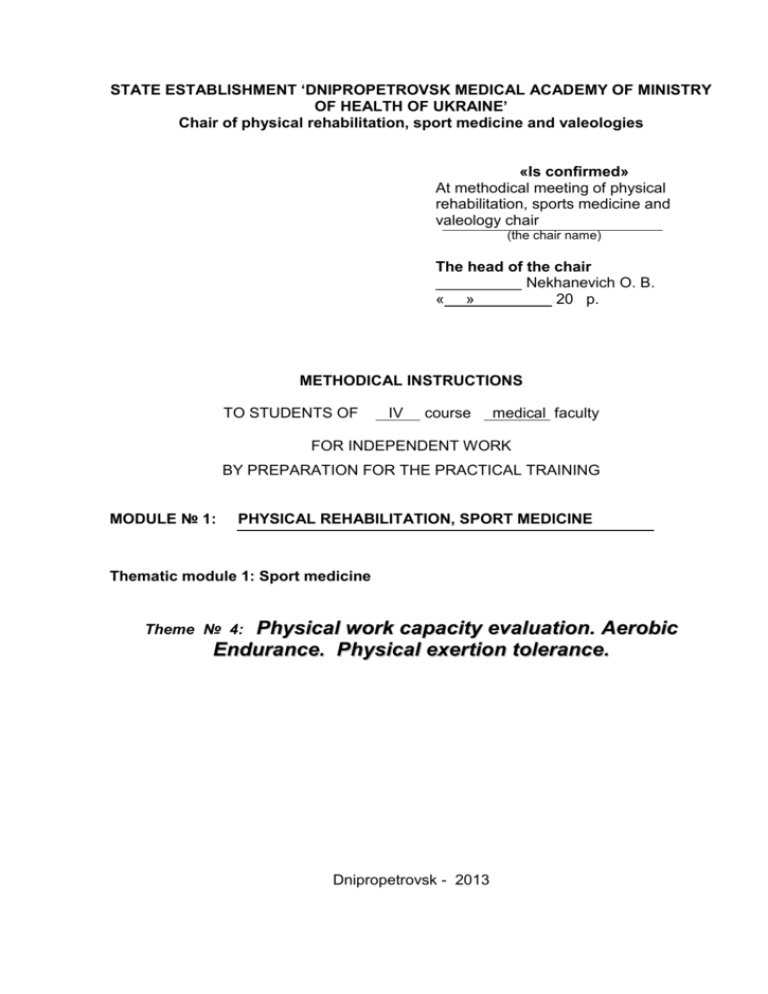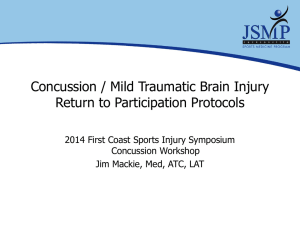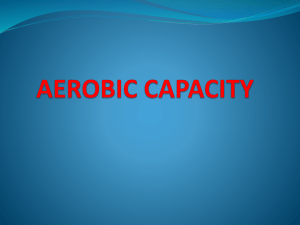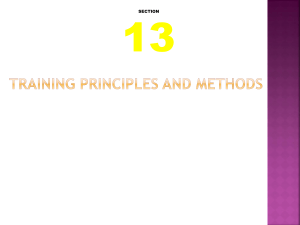Submaximal PWC 170 test.
advertisement

STATE ESTABLISHMENT ‘DNIPROPETROVSK MEDICAL ACADEMY OF MINISTRY OF HEALTH OF UKRAINE’ Chair of physical rehabilitation, sport medicine and valeologies «Is confirmed» At methodical meeting of physical rehabilitation, sports medicine and valeology chair (the chair name) The head of the chair __________ Nekhanevich O. B. « » 20 р. METHODICAL INSTRUCTIONS TO STUDENTS OF ІV course medical faculty FOR INDEPENDENT WORK BY PREPARATION FOR THE PRACTICAL TRAINING MODULE № 1: PHYSICAL REHABILITATION, SPORT MEDICINE Thematic module 1: Sport medicine Physical work capacity evaluation. Aerobic Endurance. Physical exertion tolerance. Theme № 4: Dnipropetrovsk - 2013 MODULE І. PHYSICAL REHABILITATION, SPORT MEDICINE Thematic module 1: Sport medicine Theme № 4: Physical work capacity evaluation. Aerobic Endurance. Physical exertion tolerance. 1. Theme urgency: Functional diagnostics is the way to indicate the problems in functional state of organism. It is equally important to professional sport, general physical education and remedial gymnastics. General and specific adaptive facilities are controlled with functional tests. The test can be held on the functional diagnostics center or during the physical training activity. The results contain information about functional state of organism, the adaptive abilities and physical training tolerance at the exact time. 2. Theme duration: 4 hours. 3. The educational aim: To study the functional tests, including loading tests. To evaluate physical work capacity, aerobic endurance and physical activity tolerance. Concrete aims: To know: - Theoretic basement, administration and evaluation principles of functional loading tests. Their features and practical use in functional diagnostics. - Loading tests; - What «physical work capacity», «aerobic endurance» and «physical training tolerance» is?; - The terms of holding a loading test; - Clinical and functional features of tolerance threshold; - physical work capacity and human physical health characteristics To be able: - to evaluate indications and contraindications to providing the loading test; - to estimate physical work capacity with PWC170 test (veloergometric and stepergometric variants); - to estimate physical work capacity and physical exertion tolerance with Navakki test; - to estimate the aerobic endurance Astrand, Kuper metods or PWC170 test; - to evaluate loading tests results; - work with medical documents. To develop practical skills: - the self-holding functional tests: PWC170 (veloergometric and stepergometric variants); Navvacki test - calculate the aerobic endurance index with Astrand or PWC170 metods; . - work with special medical documents. 4. Basic knowledge, skills (interdisciplinary integration) – (table 4.1): Table 4.1 The names of previous disciplines Normal physiology Practical skills To be able to registrate main physiologic features, to know the loading test methodic. Propedeutics of internal disease To define the development process of prepathologic and pathologic organic changes, non-adequate physical exertion impact To take blood pressure, heart rate, describe pulsus. To be able to take electrocardiography, to hold the loading test. To evaluate the medical data. Pediatric Propedeutics To know the specifics of physical development in children according to different age. Pathologic physiology 5. Students advice. 5.1 Theoretic qestions: 1. Loading tests and their features. 2. Indications and contraindications to providing loading tests; conditions need higher attention during testing. 3. The terms of holding a test. 4. Test variants. The start level of the load for testing. 5. What «physical work capacity», «aerobic endurance» and «physical exertion tolerance» is?. 6. Direct and indirect methods of estimation physical work capacity and aerobic endurance. 7. Clinical and functional features of tolerance threshold. 8. Submaximal PWC170 test. Holding methodic. The principles of estimation thee physical work capacity in PWC170 test(veloergometric and stepergometric variants). 9. The estimation of maximal oxygen consumption. The calculation of the maximal oxygen consumption factor by Astrand`s nomogram and by PWC170 value. 10. Navakki test, Holding methodic and results evaluation. 11. Functional classes of physical state according to the load and aerobic performance. 12. The connection between physical work capacity and human physical health characteristics. 5.2 Practical part: 1. describe Harvard step-test methodic and result evaluation. 2. describe Kuper test methodic and result evaluation 3. Describe the estimation of glicolitic, Oxidative-glicolitic and oxidativecapacity in human musculs. 4. Calculate the maximal oxygen consumption factor by PWC170 value. 1. Estimate physical work capacity with PWC170 test (veloergometric and stepergometric variants), evaluate the results. 2. to estimate physical work capacity and physical exertion tolerance with Navakki test, evaluate the results. 3. Calculate the maximal oxygen consumption factor by PWC170 value. 4. To give a mark to general functional resources oh an organism. 5. Give recommendations about the kind of physical activity and optimal moving mood depending on test results. 5.4. Theme content: Functional loading tests give us a chance to register parameters while physical exertion. It establishes a quantitative score of functional abilities using special diagnostic equipment. It is necessary to take into account several personal data: State of the athlete (health, composure), Physiological data (body weight, resting heart rate) to choose the loading level. Load testing means an athlete does intensive physical exertion. That is why the testing grope should include a physician and a nurse. They control whether the test is held right, the appearance of pathologic signs and decide when the test should be stopped. After recording the data the dynamic of physiological parameters is analysed. Indications to load testing: а) sport medicine: 1. Functional reserve and functional abilities estimation 2. Sport determination. 3. Training efficiency in different period estimation. 4. Training program design. 5. Sport results, Endurance development prognoses. б) medical science: 1. 2. 3. 4. 5. 6. Functional state evaluation. Hidden forms of the disease estimation, (especially cardiovascular). Moving mood selection/ correction. Individual rehabilitation program optimization. Evaluation of the rehabilitation efficiency. Work eligibility estimation (лікарсько-трудова експертиза). Contraindications to load testing: Absolute: 1. Acute inflectional disease and reconvalescention period. 2. High level of coronary insufficiency (rest angina, instable angina, severe angina). 3. Pre-infarctional state, acute heart attack. 4. Active phase of miocarditis 5. Evident arythmia (frequent, grope or early extrasystoles, paroxysmal tachicardia, cardiac fibrillation) or conductivity disfunction (block II-III). 6. Heart abnormalities with intensive heart load. 7. Heart insufficiency stage ІІ–ІІІ. 8. Trombophlebitis, tromboembolia risk. 9. Heart or vascular aneurysmus. 10. Exacerbation of chronic respiratory disease (chronic bronchitis, pneumonia, bronchial asthma) 11. Cancer and non-reversible progressive proceses. 12. Patient`s disagreement. Relative: 1. Reconvalescention period after heart attack (3 month). 2. Sinus tachicardia (heart rate more than 100 beets/min). 3. Severe arterial hypertension (BP higher than 240/120 мм рт.ст.). 4. WPW syndrome (premature ventricular activation). 5. Severe heart dilatation. 6. Severe anemia (Hb lower than 2,6 mml/l). 7. Respiratory insufficiency (LVC lower 50%). 8. Gestational toxicosis . 9. Dismetabolism (diabetics, thyreoid toxicosis) 10. Mind derange. 11. Bone, muscular, nervous disease, that may interrupt the testing proces. With special care: 1. 2. 3. 4. 5. 6. 7. Essentional hypertension. Stable angina. Disembriogenetical abnormalities without miocardiac hyperload. Postinfarctional miocardiosclerosis. Respiratory insufficiency without LVC lowering. Obesity stage II and higher. Cardiac medication use. Equipment: 1. Different ergometers (veloergometer, stages, treadmill); 2. Diagnostics equipment(electrocardioscope, electrocardiograph, pulsotachometer, rheograph, gase analiser); 3. Drug case, defibrilator and artificial lung ventilator. TOLERANCE EVALUATION TO PHYSICAL EXERTION Tolerance to physical training is the ability to make the physical exertion without symptoms of overload. Such symptoms are called the tolerance threshold. CLINIC SYMPTOMS OF TOLERANCE THRESHOLD: 1. Complaints of the patient on difficult breathing especially in expiration (indicator of bronchoconstriction development). 2. Deep dyspnea. 3. Angina pectoris attack. (without changes on ECG). 4. Deep overfatigue, sickness, deranged vision and hearing. 5. Pale color or cyanosis of the skin, less of extremities temperature. 6. Hyperhydrosis. 7. Dyscoordination of the movements. 8. Breaking down the physical exertion by a patient. Functional features of physical threshold: Maximal HR: - For person who are training: 220 – age in years - For person who aren’t training: 200 – age in years Decrease of HR when the load increases. Maximal BP: - increase of BP more then (more 240/120 ммHg in training person, more 200/100 in don’t training ммHg) - decrease of SBP more then 25% from initial - decrease of pulse BP Electrocardiographic features: 1. Arrhythmia: premature contractions (frequent (more then 1 in 10 beats), group (two or more), multifocal, occur on or near the T wave), paroxysmal tachycardias, ventricular flutter and others) and conduction (complete heart block, ventricular blocks). 2. ST segment changes: - depression ST more 0,1 мВ during 0,08 sec. and more; - elevation ST more 0,2 мВ. 3. Т wave changes: - elevation Т more then 0,5 мВ (especially in V4 lead); - decrease voltage Т more then 25% from initial. 4. R wave changes: - decrease R amplitude more 50% from initial; - increase R amplitude with ST depression. - increase and wide Q wave PHYSICAL EVALUATION WORK CAPACITY AND AEROBIC PERFORMANCE ESTIMATION AND The loading tests give us an opportunity to evaluate physical work capacity, depending on aerobic performance. It represents the functional state of organism and its adaptive skils. Physical work capacity is potential abilities of human to make maximal physical work on safety level selected period of time. Aerobic capacity is ability of body uptake of oxygen; another term is maximum oxygen uptake is volume of oxygen used when a person reaches his maximum ability to supply it during exercise. There are direct and indirect methods of physical work capacity estimation. Direct: execution of maximal physical exertion, on limit of aerobic capacity. Used only for Indirect: a. Submaximal test PWC170 b. Navvacki test d. The step test c. The 12-minute run test (Cooper’s test) Submaximal PWC170 test. Testing and measurement are the means of collecting information upon which subsequent performance evaluations and decisions are made but in the analysis we need to bear in mind the factors that may influence the results. The primary purpose of the PWC170 test (Cambell et al. 2001)[1] is to predict the power output (watts) at a projected heart rate of 170 beats per minute (bpm). ЧСС за 1 хв. 180 170 160 150 140 130 120 110 100 90 80 70 W 60 70 75 100 125 150 175 200 225 250 300 Рис. 5.1. HR to loading power dependance There are two variants of PWC170 test: veloergometric and stepergometric This test requires the athlete to cycle for 6 minutes whilst maintaining their heart rate between 120140bpm and the following a 10 minute rest cycle for another 6 minutes whilst maintaining their heart rate between 150-170bpm. • The athlete starts cycling • The assistant adjusts load on the bicycle ergometer to raise the athlete’s heart rate to between 120-140bpm • The assistant resets the power output to zero and starts the stopwatch • After 6 minutes the assistant records the power output (P1) and the athlete’s average heart rate (H1) • The athlete rests for 10 minutes • The athlete starts cycling • The assistant adjusts load on the bicycle ergometer to raise the athlete’s heart rate to between 150-170bpm • The assistant resets the power output to zero and starts the stopwatch • After 6 minutes the assistant records the power output (P2) and the athlete’s average heart rate (H2) Harvard step test The Harvard Step test is a test of aerobic fitness, developed by Brouha et al. (1943) in the Harvard Fatigue Laboratories during WWII. The features of this test is that it is simple to conduct and requires minimal equipment. There are many other variations of step tests too.Step Test Image equipment required: step or platform 20 inches / 50.8 cm high, stopwatch, metronome or cadence tape. Procedure: The athlete steps up and down on the platform at a rate of 30 steps per minute (every two seconds) for 5 minutes or until exhaustion. Exhaustion is defined as when the athlete cannot maintain the stepping rate for 15 seconds. The athlete immediately sits down on completion of the test, and the total number of heart beats are counted between 1 to 1.5 minutes after finishing (see measuring heart rate). This is the only measure required if using the short form of the test. If the long form of the test is being conducted, there is an additional heart rate measures at between 2 to 2.5 minutes, and between 3 to 3.5 minutes. See some videos of Harvard Step tests being performed. Scoring: the Fitness Index score is determined by the following equations. For example, if the total test time was 300 seconds (if completed the whole 5 minutes), and the number of heart beats between 11.5 minutes was 90, between 2-2.5 it was 80 and between 3-3.5 it was 70, then the long form Fitness Index score would be: (100 x 300) / (240 x 2) = 62.5. Note: you are using the total number of heart beats in the 30 second period, not the rate (beats per minute) during that time. Fitness Index (short form) = (100 x test duration in seconds) divided by (5.5 x pulse count between 1 and 1.5 minutes). Fitness Index (long form) = (100 x test duration in seconds) divided by (2 x sum of heart beats in the recovery periods). fitness index (long form) rating excellent > 96 good 83 - 96 average 68 - 82 low average 54 - 67 poor < 54 (norms from: Fox et al. 1973) Validity: correlation to VO2max has been reported as between 0.6 to 0.8 in numerous studies. Advantages: This test requires minimal equipment and costs, and can be self-administered. Disadvantages: Biomechanical characteristics vary between individuals. For example, considering that the step height is standard, taller people are at an advantage as it will take less energy to step up onto the step. Body weight has also been shown to be a factor. Testing large groups with this test will be time consuming. Comments: The Harvard Step Test was developed by Brouha et al. (1943) in the Harvard Fatigue Laboratories during WWII. Some sources suggest a 40 cm high bench, which is not the standard and original bench height. Since the original description of this test, there have been variations in the test procedure such as reducing the bench height for female subjects in some research studies. Navvacky test. It is one of most simplex test. In this test Is investigated time during which the patient makes physical exertion in fixed level. For this test is used the cyclergometer. The type of exertion: increase the power of exertion in stages. Initial level of the exertion is 1 Vt\kg. Every level of exertion the patient makes 2 min. After every stage is evaluated the symptoms of tolerance threshold. If they are present the test is stopped, if they aren’t the power level increased on 1 Vt\kg. Table 5.1. Navvacki test evaluation scale The power of exertion (Vt\kg) Time of work in every stage (min) Test assessment 2 1 Low PW C in person isn’t training 3 1 Satisfactory PW C in person isn’t training 3 2 Normal PW C in person isn’t training 4 1 Satisfactory PW C in training person 4 2 Normal PW C in training person 5 1-2 High PW C in training person 6 1 Very high PW C in training person The Cooper test is a test of physical fitness. It was designed by Kenneth H. Cooper in 1968 for US military use. In the original form, the point of the test is to run as far as possible within 12 minutes. The test is meant to measure the condition of the person taking it and therefore it is supposed to be run at a steady pace instead of sprints and fast running. The outcome is based on the distance the test person ran, their age and their sex. The results can be correlated with VO2 Max. It is an easy test to perform on larger groups. The length of the run is considered to be that of a long distance run, since everything above 3 km is rated "long distance"—which means the runner will predominately use his "red", slow oxidative muscle cells. For comparison the 5000 meters world record of Kenenisa Bekele was performed in 12:37.35. This means that in 12 minutes he would reach a distance of around 4750 meters. An estimate of your VO2 max can be calculated as follows: VO2 Max = 1,7 х РWC170 + 1240 VO2 Max = 2,2 х РWC170 + 1070 VO2 Max is ml/min, аnd РWC170 is kgm/min. Score: the VO2 Max quantity should correlate with body weight. VO2 Max in non-athletes male is 44-51 ml/min/kg, in female 35-38 ml/min/kg represents norma. VO2 Max index lower than 25 ml/min/kg in male and 20,5 ml/min/kg in female represents severe functional state, more than 51,5 ml/min/kg in male and 38,9 ml/min/kg in female represents perfect functional state. In athlets VO2 Max may oveergrade 80-90 ml/min/kg. 5.3 Self-control materials: 1) self-control questiones: 1. Give the general characteristic and special features of loading tests. 2. Give indications and contraindications for loading tests. 3. Indicate start level and kinds of the load for load testing. 4. Formulate the definition for physical work capacity, aerobic performance and physical exertion tolerance. 5. Mark clinical and functional symptoms of physical exertion tolerance threshold. 6. Give the direct and indirect methods of estimation the physical work capacity. 7. Describe the method and calculating the results for submaximal PWC170 test veloergometric variant. 8. Describe the method and calculating the results for submaximal PWC170 test stepergometric variant. 9. What is maximal oxygen consumption? 10. Describe methods of maximal oxygen consumption estimation. 11. Navvacki test: method and scoring the results 12. Physical state classes and their features. 2) Тests: 1) Clinical indications of reaching tolerance threshold to physical load is: A. increased sweating B. Intensified and deep breathing C. Appearance of internal chest pain D. Insignificant hyperemia E. *heartbeat. 2) While calculating powerfulness of physical load in case of stepergometry all indices are used except one: A. *Height while standing tall B. Mass of a body C. height of a stair D. Pace of going up E. Correcting coefficient 3) Clinical mind improvement The boy, age 8, after acute tonsilitis desidedd to train football, despite medical prohibition. What are possible complications? literature: the main 1. Remedial gymnastics and sport medicine: textbook/ Klapchuk V.V., Dsiak G.V., Mutavov V.I.; red. Klapchuk V.V., Dsiak G.V. – К.: Zdorov`e, 1995. – 312 p. 2. Remedial gymnastics and sport medicine: Tests for knowlage control in students of medical and stomatological faculties of universitie ІУ level of acreditation / Abramov В.В., Klapchuk В.В., Magl`ovanuy А.V., Smirnova О.L.,; red. Ph. Klapchuk V.V., Ph. Magl`ovanuy А.V. – Dnipropetrovsk: medical academy, 2006. – 124 p. 3. Remedial gymnastics and sport medicine (Lections) / Abramov В.В., Klapchuk V.V Smirnova О.L.,.; red. Ph. Klapchuk V.V.,– Dnipropetrovsk: medical academy, 2006. – 179 p 4. Medical control in physical training and sports: medical recommendations for students of medical and stomatological faculties of universitie ІУ level of acreditation / V.S. Sokolovskyy, N.А. Romanova, V.S. Vladova, I.I. Bondarev. – Odessa: osmu, 2001. – 93p. 5. Sport medicine. textbook / Makarova G.А. – М.: Soviet sport, 2003. – 480 p. 6. Textbook «Remedial gymnastics and medical control» red. Epifanova and G. L. Apanasenko – p.14-16, 25-37. 7. Functional tests in sport medicine (methodical recomendations) /Mychaluk E. L. –Kyiv. –2005. – 37p. Discussed on cathedral meeting «____»___________20___р. (Protocol № ____) The head of the cathedra, Phd. _________________ О.B.Nekhanevich Discussed on cathedral meeting «____»___________20___р. (Protocol № ____) The head of the cathedra, Phd. _________________ О.B.Nekhanevich







